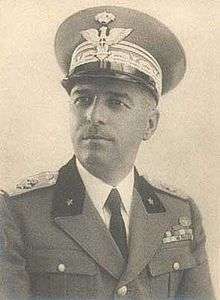Axis order of battle for the invasion of Yugoslavia
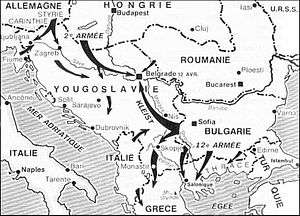
The Axis order of battle for the invasion of Yugoslavia was made up of the various operational formations of the German Wehrmacht and Waffen-SS, Italian Armed Forces and Hungarian Armed Forces that participated in the invasion of Yugoslavia during World War II, commencing on 6 April 1941. It involved the German 2nd Army, with elements of the 12th Army and a panzer group combined with overwhelming Luftwaffe (German Air Force) support. The eighteen German divisions included five panzer divisions, two motorised infantry divisions and two mountain divisions. The German force also included two well-equipped independent motorised regiments and was supported by over 800 aircraft. The Italian 2nd Army and 9th Army committed a total of 22 divisions, and the Royal Italian Air Force (Italian: Regia Aeronautica) had over 650 aircraft available to support the invasion. The Hungarian 3rd Army also participated, with support from the Royal Hungarian Air Force (Hungarian: Magyar Királyi Honvéd Légierő, MKHL).
The Axis ground forces had effectively surrounded the Kingdom of Yugoslavia before the invasion began. The German 2nd Army, consisting of one motorised, one mountain, and two infantry corps was concentrated in southwestern Hungary and southeastern Austria, poised to drive south and east. One motorised corps of the German 12th Army was assembled near Sofia, Bulgaria, along with one motorised corps of the First Panzer Group, and these formations were assigned the task of striking the strongest Yugoslav formations stationed along the eastern border of the country. A further motorised corps was deployed near Timișoara in western Romania, ready to thrust south into the Banat region. The Italian 2nd Army, consisting of one fast (Italian: celere) corps, one motorised corps and three infantry corps was assembled in northeastern Italy, with the task of driving southeast down the Dalmatian coast. The Italian 9th Army, comprising two corps and a sector defence command, was stationed in occupied northern Albania, and its stance was largely defensive. The Hungarian 3rd Army was concentrated along the Yugoslav border largely between the Danube and the Tisza, with the objective of seizing the Bačka and Baranja regions.
German, Italian and Hungarian air support was concentrated in Austria, Italy, southern Hungary, southern Romania, western Bulgaria and Albania. In total, over 1,500 Axis aircraft were available to support the invasion. Naval forces were limited to a few destroyers of the Royal Italian Navy (Italian: Regia Marina) operating in the Adriatic Sea.
German
German land forces
The German formations committed to the invasion of Yugoslavia included over 337,000 men, and more than 2,000 mortars, 1,500 artillery pieces, 1,100 anti-tank guns, 875 tanks and 740 other armoured fighting vehicles.[1] The German land forces were under the overall direction of the commander of the German Army Generalfeldmarschall (Field Marshal) Walther von Brauchitsch.[2]
2nd Army
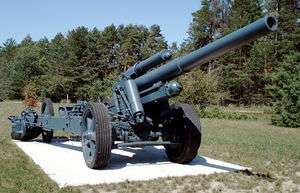
The German 2nd Army was commanded by Generaloberst (General) Maximilian von Weichs, consisted of one motorised, one mountain, and two infantry corps, and was assembled in southwestern Hungary and southeastern Austria.[3][4] The LII Infantry Corps suffered significant delays in deploying to its assembly area and was initially held in reserve.[5] According to Schreiber, Stegemann and Vogel, three panzer divisions, four infantry divisions and one motorised infantry division were planned as reserves for the 2nd Army, but they did not participate in the fighting in Yugoslavia.[6] According to Niehorster, these divisions were held as theatre reserves or were allocated to various formations.[2][7][lower-alpha 1] 2nd Army was supported by three bridging battalions and a road construction battalion.[7]
| Corps | Commander | Assembly area | Division |
|---|---|---|---|
Nagykanizsa,[8] southwest Hungary |
8th Panzer Division | ||
| 14th Panzer Division | |||
| 16th Motorised Infantry Division | |||
| southeast of Klagenfurt, Austria |
1st Mountain Division | ||
| 79th Infantry Division[lower-alpha 2] | |||
| 538th Frontier Guard Division | |||
General der Infanterie Hans-Wolfgang Reinhard | Leibnitz, Austria |
101st Light Infantry Division[lower-alpha 3] | |
| 132nd Infantry Division | |||
| 183rd Infantry Division | |||
LII Infantry[lower-alpha 4] | General der Infanterie Kurt von Briesen | Leibnitz, Austria |
125th Infantry Division[lower-alpha 5] |
XLVI Motorised Corps was supported by three motorised heavy artillery battalions, a motorised pioneer battalion, a road construction battalion, six bridging columns and two Luftwaffe anti-aircraft battalions. XLIX Mountain Corps included two motorised heavy artillery battalions and a road construction battalion. LI Infantry Corps included seven motorised heavy artillery battalions, two assault gun battalions, two motorised pioneer battalions, two bridging battalions, two road construction battalions and twelve bridging columns.[7]
12th Army

The German 12th Army was commanded by Generalfeldmarschall Wilhelm List,[9] and consisted of one mountain, three infantry and two motorised corps.[10][lower-alpha 6] Most of the 12th Army was deployed along the Bulgarian-Greek border in preparation for the invasion of Greece,[12] and of the corps commanded by List, only the two motorised corps were committed to the invasion of Yugoslavia. For the first phase of the invasion of Yugoslavia, the First Panzer Group was also assigned to the 12th Army.[10]
| Corps | Commander | Assembly area | Division or regiment |
|---|---|---|---|
General der Panzertruppe Georg Stumme | Kyustendil southwest of Sofia, Bulgaria |
9th Panzer Division | |
| 73rd Infantry Division | |||
| Leibstandarte SS Adolf Hitler | |||
General der Panzertruppe Georg-Hans Reinhardt | SS Motorised Infantry Division Reich | ||
| Großdeutschland Motorised Infantry Regiment | |||
XL Motorised Corps was supported by one motorised anti-tank battalion, three motorised heavy artillery battalions, two motorised pioneer battalions, two bridging battalions and three motorised bridging columns. XLI Motorised Corps included two motorised heavy artillery battalions and a motorised pioneer battalion.[11]
First Panzer Group

The First Panzer Group was commanded by Generaloberst Paul Ludwig Ewald von Kleist, and according to Schreiber, Stegemann and Vogel, it consisted of XIV Motorised Corps with two panzer divisions, one mountain, one motorised infantry and one infantry division.[10] According to Niehorster, the XLI Motorised Corps was also assigned to First Panzer Group.[11][lower-alpha 7] It assembled northwest of Sofia, Bulgaria.[10]
| Corps | Commander | Division |
|---|---|---|
XIV Motorised | General der Infanterie Gustav Anton von Wietersheim |
5th Panzer Division |
| 11th Panzer Division | ||
| 294th Infantry Division | ||
| 4th Mountain Division | ||
| 60th Motorised Infantry Division | ||
The First Panzer Group was supported by one motorised heavy artillery battalion, one motorised pioneer battalion, one pioneer battalion, two bridging battalions and two bridging columns. Supporting units of XIV Motorised Corps included two motorised heavy artillery battalions, a motorised pioneer battalion, two bridging columns and one Luftwaffe motorised anti-aircraft battalion.[11]
Commanders
| Major German formation commanders | ||||||||||||||||
|---|---|---|---|---|---|---|---|---|---|---|---|---|---|---|---|---|
|
German Air Force
The Luftwaffe operated out of bases in Austria, Romania and Bulgaria during the invasion of Yugoslavia. In total, the Germans had over 809 aircraft available to support the invasion of Yugoslavia, more than half of which were positioned in Bulgaria to support the simultaneous invasion of Greece. In total, the Germans fielded 296 fighter aircraft, 89 light bombers, 26 medium bombers and 23 reconnaissance aircraft, and more than 318 dive bombers and 57 heavy fighters. In addition, a reconnaissance squadron equipped with Henschel Hs 126 two-seater reconnaissance aircraft was attached to most of the corps headquarters and every panzer division of the German ground forces.[13][14] Luftwaffe anti-aircraft units were also attached to the German land forces.[14]
4th Air Fleet
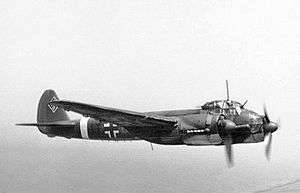
The Luftwaffe 4th Air Fleet (German: Luftflotte IV) was commanded by General der Flieger (Lieutenant General) Alexander Löhr, had its headquarters in Vienna,[15] and direct command units based on airfields in western Austria. These units included one squadron (German: Staffel) of the 121st Reconnaissance Group (German: Aufklärungsgruppe 121), the entire 51st Bomber Wing (German: Kampfgeschwader 51, KG 51), and four bomber groups (German: Kampfgruppen) drawn from the 2nd, 3rd and 4th Bomber Wings (KG 2, KG 3 and KG 4). In total, the 4th Air Fleet had 25 medium bombers, 89 light bombers, 55 dive bombers, 6 reconnaissance aircraft and 1 heavy fighter available in Austria to support the invasion of Yugoslavia.[13][14]
| Unit | Location | Aircraft type |
|---|---|---|
| 4th Squadron/121st Long Range Reconnaissance Group | 6 × Junkers Ju 88D long-range photo-reconnaissance aircraft 1 × Messerschmitt Bf 110C heavy fighter | |
| Headquarters 2nd Bomber Wing | 6 × Dornier Do 17Z light bombers | |
| I Group/2nd Bomber Wing | Zwölfaxing | 28 × Dornier Do 17Z light bombers |
| III Group/2nd Bomber Wing | Zwölfaxing | 29 × Dornier Do 17Z light bombers |
| III Group/3rd Bomber Wing | 26 × Dornier Do 17Z light bombers | |
| II Group/4th Bomber Wing | 25 × Heinkel He 111P medium bombers | |
| Headquarters 51st Bomber Wing | 1 × Junkers Ju 88A dive bomber | |
| I Group/51st Bomber Wing | Wiener Neustadt | 17 × Junkers Ju 88A dive bombers |
| II Group/51st Bomber Wing | Wiener Neustadt | 18 × Junkers Ju 88A dive bombers |
| III Group/51st Bomber Wing | 19 × Junkers Ju 88A dive bombers | |
Fliegerführer Graz
Fliegerführer Graz was commanded by Oberstleutnant (Lieutenant Colonel) Karl Christ, commander of the 3rd Dive Bomber Wing (German: Sturzkampfgeschwader 3, StG 3). It was located in Graz, Austria, and consisted of the headquarters and II Group of StG 3, the headquarters and II Group (German: Jagdgruppe) of the 54th Fighter Wing (German: Jagdgeschwader 54, JG 54) (less one squadron), and I Group of the 27th Fighter Wing (JG 27). In total, Fliegerführer Graz had 54 fighters, 1 medium bomber and 35 dive bombers available to support the invasion of Yugoslavia.[13][14]
| Unit | Aircraft type |
|---|---|
| Headquarters 3rd Dive Bomber Wing | 1 × Junkers Ju 87B dive bomber 1 x Heinkel He 111H medium bomber |
| II Group/3rd Dive Bomber Wing | 34 × Junkers Ju 87B dive bombers |
| Headquarters 54th Fighter Wing | 3 × Messerschmitt Bf 109E fighters |
| II Group/54th Fighter Wing (part) | 24 × Messerschmitt Bf 109E fighters |
| I Group/27th Fighter Wing | 27 × Messerschmitt Bf 109E fighters |
Fliegerführer Arad
Fliegerführer Arad was commanded by Oberstleutnant Clemens Graf von Schönborn-Wiesentheid, commander of the 77th Dive Bomber Wing (StG 77). With its headquarters in Arad, Romania, it consisted of the headquarters, I and III Groups of StG 77, headquarters, II and III Groups of the 77th Fighter Wing (JG 77), one squadron of II Group of JG 54, III Group of JG 54 and I Group of the 26th Heavy Fighter Wing (German: Zerstörergeschwader 26, ZG 26). In total, Fliegerführer Arad had 116 fighters, 31 heavy fighters and 68 dive bombers available to support the invasion of Yugoslavia.[13][14]
| Unit | Location | Aircraft type |
|---|---|---|
| Headquarters 77th Dive Bomber Wing | Arad | 3 × Junkers Ju 87B dive bombers 4 × Messerschmitt Bf 109E fighters |
| I Group/77th Dive Bomber Wing | Arad | 33 × Junkers Ju 87B dive bombers 1 × Messerschmitt Bf 110C heavy fighter |
| III Group/77th Dive Bomber Wing | Arad | 32 × Junkers Ju 87B dive bombers |
| Headquarters 77th Fighter Wing | 6 × Messerschmitt Bf 109E fighters | |
| II Group/77th Fighter Wing | Deta | 34 × Messerschmitt Bf 109E fighters |
| III Group/77th Fighter Wing | Deta | 33 × Messerschmitt Bf 109E fighters |
| 4th Squadron/II Group/54th Fighter Wing | Arad | Messerschmitt Bf 109E fighters |
| III Group/54th Fighter Wing | Arad | 39 × Messerschmitt Bf 109E fighters |
| I Group/26th Heavy Fighter Wing | Szeged, Hungary | 30 × Messerschmitt Bf 110C/D heavy fighters |
VIII Air Corps
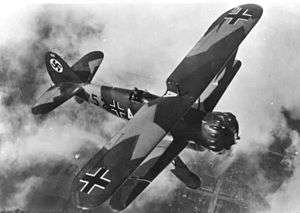
The VIII Air Corps (German: Fliegerkorps VIII) was commanded by General der Flieger Wolfram Freiherr von Richthofen, who had operational control of all air operations for the invasion.[15] With its headquarters in Gorna Dzhumaya, Bulgaria, it was based at various airfields in western Bulgaria, and consisted of one squadron of the 11th Reconnaissance Group, the headquarters, I and II Groups of the 2nd Dive Bomber Wing (StG 2), I Group of StG 3, the headquarters, II and III Groups of the 27th Fighter Wing, a fighter group and a ground attack group from the 1st Demonstration Wing (German: Lehrgeschwader 1, LG 1), and a reinforced dive bomber group from the 2nd Demonstration Wing. In total, the VIII Air Corps had 126 fighters and 17 reconnaissance aircraft, and more than 25 heavy fighters and 160 dive bombers available to support the invasions of both Yugoslavia and Greece.[13][14]
| Unit | Location | Aircraft type |
|---|---|---|
| Headquarters 2nd Dive Bomber Wing | 4 × Junkers Ju 87B dive bombers 6 × Dornier Do 17P long-range photo-reconnaissance aircraft | |
| I Group/2nd Dive Bomber Wing | Belitsa and Krainici | 30 × Junkers Ju 87B dive bombers 9 × Junkers Ju 87R long-range dive bombers |
| III Group/2nd Dive Bomber Wing | Belitsa and Krainici | 35 × Junkers Ju 87B dive bombers |
| I Group/3rd Dive Bomber Wing | Belitsa | 30 × Junkers Ju 87B dive bombers 9 × Junkers Ju 87R long-range dive bombers |
| I Group/1st Dive Bomber Wing | Krainici | 23 × Junkers Ju 87R long-range dive bombers |
| II Dive Bomber Group/2nd Demonstration Wing | 23 × Messerschmitt Bf 109E fighters | |
| 10th Dive Bomber Squadron/2nd Demonstration Wing | Krainici | 20 × Henschel Hs 123A biplane dive bomber |
| II Group/26th Heavy Fighter Wing | Kraishte and Vrazhdebna | 25 × Messerschmitt Bf 110C/E heavy fighters |
| Headquarters 27th Fighter Wing | Belitsa and Sofia | 5 × Messerschmitt Bf 109E fighters |
| II Group/27th Fighter Wing | Belitsa and Sofia | 37 × Messerschmitt Bf 109E fighters |
| III Group/27th Fighter Wing | Belitsa and Sofia | 39 × Messerschmitt Bf 109E fighters |
| I Fighter Group/2nd Demonstration Wing | Vrazhdebna | 22 × Messerschmitt Bf 109E fighters |
| I Group/1st Demonstration Wing | Vrazhdebna | Junkers Ju88A dive bombers |
| 2nd Squadron/11th Long Range Reconnaissance Group | Sofia | 11 × Dornier Do 17P long-range photo-reconnaissance aircraft |
| 7th Squadron/2nd Demonstration Wing | Vrazhdebna | Messerschmitt Bf 110C heavy fighters |
| 7th Sea Rescue Squadron | various floatplanes | |
| IV Group/1st Transport Group | Junkers Ju 52/3m transport aircraft | |
X Air Corps
The X Air Corps (German: Fliegerkorps X) was based in Sicily, and consisted of four bomber groups, one heavy fighter group and one fighter squadron with a total of 168 aircraft.[16] It was available to provide on-call support to the 4th Air Fleet as required,[1] but only a few units played any part in supporting the invasion because the primary task of X Air Corps was interdicting Allied supply convoys to Malta.[17] Units earmarked for support to the invasion included 7th Squadron of 26th Fighter Wing (JG 26) equipped with Messerschmitt Bf 109E fighters, and III Group of ZG 26, flying Messerschmitt Bf 110C/D heavy fighters.[18]
Commanders
| Major German Luftwaffe commanders | ||||
|---|---|---|---|---|
|
Italian
Italian ground forces
The Italian 2nd Army and 9th Army committed a total of 22 divisions to the operation,[19] comprising around 300,000 troops.[20] The Italian ground forces included the Italian garrison of Zara, which was an Italian enclave on the Dalmatian coast.[21]
2nd Army

The Italian 2nd Army (Italian: 2° Armata) was commanded by Generale designato d’Armata (acting General) Vittorio Ambrosio,[22] and consisted of one fast (Italian: celere) corps, one motorised corps and three infantry corps, and was assembled in northeastern Italy.[23][24] The 2nd Army was supported by a motorised engineer regiment including three bridging battalions, a chemical battalion, fifteen territorial battalions, and two garrison battalions.[25]
| Corps | Commander | Division |
|---|---|---|
| 1st Cavalry Division Eugenio di Savoia | ||
| 2nd Cavalry Division Emanuele Filiberto Testa di Ferro | ||
| 3rd Cavalry Division Amedeo Duca d'Aosta | ||
| 15th Infantry Division Bergamo | ||
| 57th Infantry Division Lombardia | ||
| Guardia alla Frontiera (Border Guard)[lower-alpha 8] | ||
Generale di Corpo d'Armata Lorenzo Dalmazzo |
12th Infantry Division Sassari | |
| 20th Infantry Division Friuli | ||
| 26th Mountain Infantry Division Assietta | ||
Generale di Divisione Mario Robotti |
13th Infantry Division Re | |
| 14th Infantry Division Isonzo | ||
| 3rd Mountain Infantry Division Ravenna | ||
| Guardia alla Frontiera (Border Guard)[lower-alpha 9] | ||
| 3rd Alpine Group[lower-alpha 10] | ||
Generale di Corpo d'Armata Francesco Zingales |
9th Motorised Division Pasubio | |
| 52nd Motorised Division Torino | ||
| 133rd Armoured Division Littorio | ||
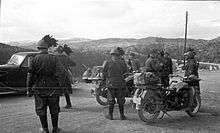
V Corps support units included three motorised artillery regiments comprising thirteen battalions, four machine gun battalions (two motorised and two pack animal), three Blackshirt legions of battalion size, a motorised anti-aircraft battalion, a sapper assault battalion and a road construction battalion. VI Corps included four motorised artillery regiments with a total of sixteen battalions, two machine gun battalions (one motorised, one pack animal) and a motorised anti-aircraft regiment. XI Corps included one motorised artillery regiment comprising four battalions, three machine gun battalions (one motorised, one pack animal and one static), and six Blackshirt legions of battalion size. The Motorised Corps was supported by a motorised artillery regiment consisting of three battalions, and an motorised engineer battalion.[25]
9th Army
The elements of the Italian 9th Army (Italian: 9° Armata) that were involved in the campaign were commanded by Generale d’Armata (General) Alessandro Pirzio Biroli, and consisted of two infantry corps and some sector troops assembled in northern Albania.[26][27]
| Corps | Commander | Division |
|---|---|---|
Generale di Divisione Giovanni Vecchi |
38th Infantry Division Puglie | |
| 4th Alpine Division Cuneense | ||
Generale di Corpo d'Armata Giuseppe Pafundi |
18th Infantry Division Messina | |
| 32nd Infantry Division Marche | ||
| 131st Armoured Division Centauro | ||
Generale di Corpo d'Armata Gabriele Nasci |
53rd Infantry Division Arezzo | |
| 41st Infantry Division Firenze | ||
| 24th Infantry Division Pinerolo | ||
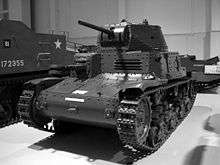
XIV Corps was supported by a cavalry regiment, three Border Guard battalions, a Finance Guard battalion and two military police (Italian: Carabinieri Reali) battalions. The XVII Corps included the Diamanti Blackshirt group which incorporated six Blackshirt regiments comprising two battalions each, the Albanian-raised Skanderbeg Blackshirt regiment of two battalions, another Blackshirt regiment of two battalions, a cavalry regiment, a Bersaglieri motorcycle battalion, three Border Guard battalions, one Finance Guard battalion, a motorised artillery regiment of three battalions, a military police battalion, and a tank company equipped with Fiat M13/40 light tanks. The Librazhd Sector included a motorised artillery regiment of four battalions, a bicycle-mounted Bersaglieri regiment, a cavalry regiment, the Biscaccianti Blackshirt group which incorporated two Blackshirt regiments with a total of five battalions, the regimental-sized Agostini Blackshirt Forest Militia, and the Briscotto group, a regimental-sized formation consisting of one Alpini battalion and two Finance Guard battalions.[28]
Zara garrison
The Zara garrison numbered about 9,000 men under the overall command of Generale di Brigata (Brigadier) Emilio Giglioli.[29] The garrison consisted of two main groupings and an assortment of supporting units. The two main groupings were the regimental-sized Fronte a Terra (Land Front), which comprised three static machine gun battalions and a bicycle-mounted Bersaglieri battalion, and the battalion-strength Fronte a Mare (Sea Front), which consisted of two machine gun companies, an anti-aircraft battery, a coastal artillery battery and a naval artillery battery. Supporting units consisted of an artillery regiment of three battalions, two independent artillery battalions, a machine gun battalion, a motorised anti-aircraft battalion (less one battery), an engineer battalion, a company of Blackshirts, and a company of L3/35 tankettes.[21]
Commanders
| Major Italian commanders | ||||
|---|---|---|---|---|
|
Royal Italian Air Force
The Royal Italian Air Force (Italian: Regia Aeronautica) operated out of bases in southeastern and northeastern Italy and Albania during the invasion of Yugoslavia. In total, the Italians had 658 aircraft available to support the invasion, 222 of which were positioned in Albania to also support the German invasion of Greece. These aircraft comprised 296 fighter aircraft, 40 dive bombers, 192 medium bombers, 12 bomber floatplanes and 118 reconnaissance aircraft.[30]
2nd Air Force
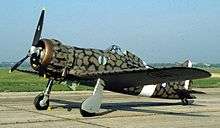
The headquarters of the 2nd Air Force (Italian: 2nd Squadra Aerea) was at Padua, in northeastern Italy under the command of Generale di Squadra Aerea (Lieutenant General) Tullio Toccolini. It comprised two fighter wings, one bomber wing, two independent bomber groups, three reconnaissance groups and one independent reconnaissance squadron. In total, the 2nd Air Force had 90 fighters, 61 medium bombers and 49 reconnaissance aircraft available to support the invasion of Yugoslavia.[30]
| Unit | Location | Aircraft |
|---|---|---|
| 4th Fighter Wing | 46 × Macchi C.200 fighters | |
| 54th Fighter Wing | 44 × Macchi C.200 fighters | |
| 18th Bomber Wing | 32 × Fiat BR.20 medium bombers | |
| 25th Bomber Group | 15 × Fiat BR.20 medium bombers | |
| 99th Bomber Group | 14 × Fiat BR.20 medium bombers | |
| 61st Reconnaissance Group | Gorizia | 8 × Caproni Ca.311 reconnaissance aircraft 8 × IMAM Ro.37bis reconnaissance biplanes |
| 63rd Reconnaissance Group | Udine | 14 × IMAM Ro.37bis reconnaissance biplanes |
| 71st Reconnaissance Group | Udine | 12 × IMAM Ro.37bis reconnaissance biplanes |
| 128th Reconnaissance Squadron | Gorizia | 7 × Caproni Ca.311 reconnaissance aircraft |
4th Air Force
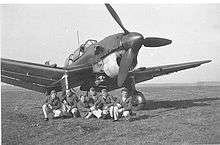
The headquarters of the 4th Air Force (Italian: 4th Squadra Aerea) was at Bari, in southern Italy under the command of Generale di Squadra Aerea Augusto Bonola. It comprised two independent fighter groups and one independent fighter squadron, four bomber wings, one combined bomber and naval bomber wing, two independent bomber groups and one independent dive bomber equipped with German Junkers Ju 87B Stuka aircraft. In total, the 4th Air Force had 73 fighters, 20 dive bombers, 131 medium bombers and 12 bomber floatplanes available to support the invasion of Yugoslavia.[30]
| Unit | Location | Aircraft |
|---|---|---|
| 8th Independent Fighter Group | 14 × Macchi C.200 fighters | |
| 153rd Independent Fighter Group | 38 × Macchi C.200 fighters 9 × Fiat CR.42 biplane fighters | |
| 370th Independent Fighter Squadron | 12 × Macchi C.200 fighters | |
| 13th Bomber Wing | 24 × Fiat BR.20 medium bombers | |
| 35th Bomber/Naval Bomber Wing | Brindisi | 15 × CANT Z.1007bis medium bombers 12 × CANT Z.1007bis bomber floatplanes |
| 37th Bomber Wing | 20 × Fiat BR.20M medium bombers 7 × Fiat BR.20 medium bombers | |
| 38th Bomber Wing | 16 × Fiat BR.20 medium bombers | |
| 47th Bomber Wing | Grottaglie | 26 × CANT Z.1007bis medium bombers |
| 50th Bomber Group | Brindisi | 8 × CANT Z.1007bis medium bombers |
| 104th Bomber Group | Foggia | 15 × Savoia-Marchetti SM.79 medium bombers |
| 97th Dive Bomber Group | Lecce | 20 × Junkers Ju 87B dive bombers |
Air Command Albania

The headquarters of Air Command Albania (Italian: Comando Aeronautica Albania) was located at Tirana, Albania under the command of Generale di Squadra Aerea Ferruccio Ranza. It comprised five fighter groups, one dive bomber group equipped with German Junkers Ju 87B Stuka aircraft, three independent reconnaissance groups and two independent reconnaissance squadrons. In total, the Italians had 133 fighters, 20 dive bombers and 69 reconnaissance aircraft available in Albania to support the invasions of Yugoslavia and Greece.[30]
| Unit | Location | Aircraft |
|---|---|---|
| 22nd Fighter Group | Tirana | 37 × Macchi C.200 fighters |
| 24th Fighter Group | 26 × Fiat G.50 fighters 1 × Caproni Ca.111 reconnaissance aircraft | |
| 150th Fighter Group | 20 × Macchi C.200 fighters | |
| 154th Fighter Group | Devoli | 20 × Fiat G.50 fighters |
| 160th Fighter Group | Tirana | 30 × Fiat CR.42 biplane fighters |
| 101st Dive Bomber Group | Tirana | 20 × Junkers Ju 87B dive bombers |
| 5th Reconnaissance Group | 18 × IMAM Ro.37bis reconnaissance biplanes | |
| 70th Reconnaissance Group | Tirana | 17 × IMAM Ro.37bis reconnaissance biplanes |
| 72nd Reconnaissance Group | Valona | 9 × IMAM Ro.37bis reconnaissance biplanes 9 × Caproni Ca.311 reconnaissance aircraft |
| 35th Reconnaissance Squadron | 8 × IMAM Ro.37bis reconnaissance biplanes | |
| 87th Reconnaissance Squadron | Tirana | 7 × Caproni Ca.311 reconnaissance aircraft |
Royal Italian Navy
Three destroyers of the Royal Italian Navy (Italian: Regia Marina) were deployed into the Adriatic in direct support of the invasion, and other units were tasked to suppress the Royal Yugoslav Navy.[20]
Hungarian
Royal Hungarian Army
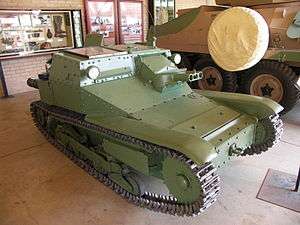
The Hungarian Army (Hungarian: Magyar Honvédség) committed the Mobile, I, IV and V Corps of Altábornagy (Lieutenant General) Elemér Gorondy-Novák's 3rd Army to the invasion. The 1st Parachute Battalion was earmarked for airborne operations.[31] The Hungarian invasion force was deployed along the Yugoslav border largely between the Danube and the Tisza.[32]
| Formation-unit | Brigade-battalion |
|---|---|
| Mobile Corps |
1st Motorised Brigade |
| 2nd Motorised Brigade | |
| 1st Cavalry Brigade | |
| I Corps |
1st Infantry Brigade |
| 13th Infantry Brigade | |
| 15th Infantry Brigade | |
| IV Corps |
2nd Infantry Brigade |
| 10th Infantry Brigade | |
| 12th Infantry Brigade | |
| V Corps |
14th Infantry Brigade |
| 19th Infantry Brigade | |
| 2nd Cavalry Brigade | |
| Independent Brigade |
9th Infantry Brigade |
| Independent Brigade |
11th Infantry Brigade |
| Independent Battalion |
1st Parachute Battalion |
Royal Hungarian Air Force

The Royal Hungarian Air Force (Hungarian: Magyar Királyi Honvéd Légierő, MKHL) committed its 1st Air Brigade to the invasion, consisting of four fighter groups of the 1st and 2nd Air Regiments flying Fiat CR.42 biplane fighters, one reinforced bomber group from the 3rd and 4th Air Regiments with Junkers Ju 86 and Caproni Ca.135bis twin-engined bombers, and one reconnaissance group from the 5th Air Regiment operating Heinkel He 170A reconnaissance aircraft.[31][33] Savoia-Marchetti SM.75 transports were used to transport the 1st Parachute Battalion.[33]
Notes
- ↑ According to Schreiber, Stegemann and Vogel, the divisions planned to be part of the 2nd Army reserve that did not reach Yugoslavia were the 4th, 12th and 19th Panzer divisions, the 20th Motorised Infantry Division, and the 100th, 169th, 179th and 197th Infantry divisions.[6] According to Niehorster, the three panzer divisions and the 100th Light Infantry Division were held as theatre reserves, the 169th and 197th Infantry divisions were assigned to 2nd Army. Niehorster does not mention the 20th Motorised Infantry Division or 179th Infantry Division.[2][7]
- ↑ According to Niehorster, the 79th Infantry Division was allocated to the LII Infantry Corps.[7]
- ↑ Only elements of the 101st Light Infantry Division were assigned to LI Infantry Corps on 5 April 1941. The remainder was not assigned until 10 April.[7]
- ↑ According to Schreiber, Stegemann and Vogel, the LII Infantry Corps was only planned for assignment to the 2nd Army on 13 April, and did not actually take over command of any formations until 15 April, when it took command of the 125th Infantry Division and elements of the 101st Light Infantry Division.[6]
- ↑ According to Schreiber, Stegemann and Vogel, the 125th Infantry Division did not reach Yugoslavia during the fighting.[6]
- ↑ According to Niehorster, XLI Motorised Corps was assigned to the First Panzer Group.[11]
- ↑ According to Schreiber, Stegemann and Vogel, the First Panzer group consisted of the XIV Motorised Corps comprising the 5th and 11th Panzer divisions, 4th Mountain Division, 60th Motorised Infantry Division and 294th Infantry Division.[10] According to Niehorster, the First Panzer Group consisted of the XIV Motorised Corps (comprising the 5th and 11th Panzer divisions), XLI Motorised Corps (comprising the SS Motorised Infantry Division Reich and the Großdeutschland Motorised Infantry Regiment), and the 4th Mountain Division and 294th Infantry Division, with the 60th Motorised Infantry Division assigned to 12th Army.[11]
- ↑ This divisional-sized Border Guard formation consisted of three regimental-sized Border Guard Sectors based around the Timavo river, the Carnavo Gulf and the city of Fiume. It was supported by a Border Guard artillery regiment of seven battalions.[25]
- ↑ This divisional-sized Border Guard formation consisted of four regimental-sized Border Guard Sectors. It was supported by two Border Guard artillery regiments, one of a single battalion, and the other comprising twelve battalions.[25]
- ↑ This regimental-sized group consisted of three Alpini battalions and a mountain artillery battalion.[25]
Footnotes
- 1 2 Zajac 1993, p. 50.
- 1 2 3 Niehorster 2013g.
- ↑ Lennox 1997, p. D-1.
- ↑ U.S. Army 1986, pp. 39–41.
- ↑ U.S. Army 1986, pp. 48–49.
- 1 2 3 4 5 Schreiber, Stegemann & Vogel 1995, p. 491.
- 1 2 3 4 5 6 Niehorster 2013h.
- ↑ U.S. Army 1986, p. 41.
- ↑ Zajac 1993, p. 49.
- 1 2 3 4 5 6 7 Schreiber, Stegemann & Vogel 1995, p. 489.
- 1 2 3 4 5 6 Niehorster 2013i.
- ↑ U.S. Army 1986, Map 3.
- 1 2 3 4 5 6 7 8 9 Shores, Cull & Malizia 1987, pp. 180–181.
- 1 2 3 4 5 6 7 8 9 10 Niehorster 2013j.
- 1 2 U.S. Army 1986, p. 39.
- ↑ Barefield 1993, p. 48.
- ↑ Shores, Cull & Malizia 1987, p. 170.
- ↑ Shores, Cull & Malizia 1987, p. 213.
- ↑ Niehorster 2013a.
- 1 2 Krzak 2006, p. 573.
- 1 2 Niehorster 2013d.
- ↑ Loi 1978, p. 32.
- ↑ Jowett 2000, p. 9.
- ↑ Loi 1978, pp. 51–54 & 186.
- 1 2 3 4 5 6 Niehorster 2013b.
- ↑ Jowett 2000, p. 10.
- ↑ Loi 1978, p. 76.
- 1 2 Niehorster 2013c.
- ↑ Loi 1978, p. 67.
- 1 2 3 4 5 6 7 Niehorster 2013e.
- 1 2 3 Niehorster 2013f.
- ↑ Tomasevich 1975, p. 67.
- 1 2 Shores, Cull & Malizia 1987, p. 222.
References
Books
- Jowett, Phillip S. (2000). The Italian Army 1940–45 (1): Europe 1940–43. Oxford, United Kingdom: Osprey. ISBN 978-1-85532-864-8.
- Loi, Salvatore (1978). Le operazioni delle unità italiane in Jugoslavia (1941–1943): narrazione, documenti [The operations of Italian units in Yugoslavia (1941–1943): narrative, documents] (in Italian). Rome, Italy: Ministero della difesa (Ministry of Defence). OCLC 9194926.
- Schreiber, Dr. Gerhard; Stegemann, Bernd; Vogel, Detlef (1995). The Mediterranean, South-East Europe, and North Africa, 1939-1941 : from Italy's Declaration of Non-belligerence to the Entry of the United States into the War. Oxford, United Kingdom: Oxford University Press. ISBN 978-0-19-822884-4.
- Shores, Christopher F.; Cull, Brian; Malizia, Nicola (1987). Air War for Yugoslavia, Greece, and Crete, 1940–41. London: Grub Street. ISBN 978-0-948817-07-6.
- Tomasevich, Jozo (1975). War and Revolution in Yugoslavia, 1941–1945: The Chetniks. Stanford, California: Stanford University Press. ISBN 978-0-8047-0857-9.
- U.S. Army (1986) [1953]. The German Campaigns in the Balkans (Spring 1941). Washington, D.C.: United States Army Center of Military History. OCLC 16940402. CMH Pub 104-4.
Journals and papers
- Barefield, Michael R. (May 1993). "Overwhelming Force, Indecisive Victory: The German Invasion of Yugoslavia, 1941". Fort Leavenworth, Kansas: School of Advanced Military Studies, United States Army Command and General Staff College. OCLC 32251055.
- Krzak, Andrzej (2006). "Operation "Marita": The Attack Against Yugoslavia in 1941". The Journal of Slavic Military Studies. 19 (3): 543–600. doi:10.1080/13518040600868123. ISSN 1351-8046.
- Lennox, Dyer T. (May 1997). "Operational Analysis: German Operations Against Yugoslavia 1941" (PDF). Newport, Rhode Island: Joint Military Operations Department, Naval War College. OCLC 227851142.
- Zajac, Daniel L. (May 1993). "The German Invasion of Yugoslavia: Insights For Crisis Action Planning And Operational Art in A Combined Environment" (PDF). Fort Leavenworth, Kansas: School of Advanced Military Studies, United States Army Command and General Staff College. OCLC 32251097.
Web
- Niehorster, Dr. Leo (2013a). "Balkan Operations Italian Order of Battle Italian Army 5th April 1941". Dr. Leo Niehorster. Retrieved 24 April 2014.
- Niehorster, Dr. Leo (2013b). "Balkan Operations Italian Order of Battle Italian Second Army 5th April 1941". Dr. Leo Niehorster. Retrieved 24 April 2014.
- Niehorster, Dr. Leo (2013c). "Balkan Operations Italian Order of Battle Italian Albanian High Command 5th April 1941". Dr. Leo Niehorster. Retrieved 24 April 2014.
- Niehorster, Dr. Leo (2013d). "Balkan Operations Italian Order of Battle Italian Commander of Troops in Zara 5th April 1941". Dr. Leo Niehorster. Retrieved 24 April 2014.
- Niehorster, Dr. Leo (2013e). "Balkan Operations Italian Order of Battle Royal Air Force 5th April 1941". Dr. Leo Niehorster. Retrieved 24 April 2014.
- Niehorster, Dr. Leo (2013f). "Balkan Operations Order of Battle 3rd Hungarian Army April 1941". Dr. Leo Niehorster. Retrieved 24 April 2014.
- Niehorster, Dr. Leo (2013g). "Balkan Operations Order of Battle German Forces April 1941". Dr. Leo Niehorster. Retrieved 24 April 2014.
- Niehorster, Dr. Leo (2013h). "Balkan Operations Order of Battle German Forces 2nd Army 5th April 1941". Dr. Leo Niehorster. Retrieved 24 April 2014.
- Niehorster, Dr. Leo (2013i). "Balkan Operations Order of Battle German Forces 12th Army 5th April 1941". Dr. Leo Niehorster. Retrieved 24 April 2014.
- Niehorster, Dr. Leo (2013j). "Luftflotte 4 on 5th April 1941". Dr. Leo Niehorster. Retrieved 24 April 2014.

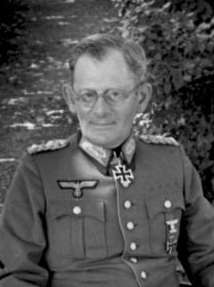

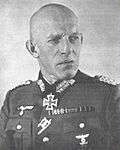
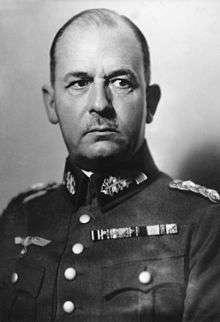

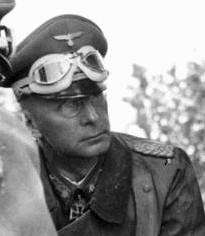
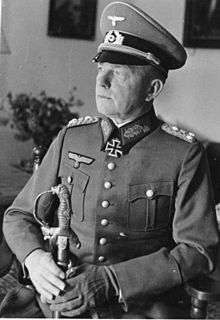

.jpg)
